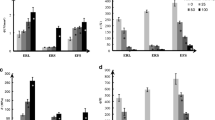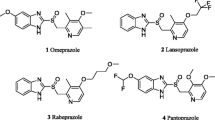Abstract
This study aimed to elucidate the mechanisms and kinetics of coating failure for enteric coated beads exposed to high-humidity conditions at different storage temperatures. Enteric coated beads were placed on high-humidity conditions (75 to 98% relative humidity (RH)) in the temperature range of 5 to 40°C. These stability samples of beads were tested for acid dissolution and water activity and also analyzed with SEM, X-ray CT, and DMA. Exposure of enteric coated beads to high humidity led to increased gastric release of drug which eventually failed the dissolution specification. SEM showed visible cracks on the surface of beads exposed to 5°C/high humidity and fusion of enteric beads into agglomerates at 40°C/high humidity. In a non-destructive time elapse study, X-ray CT demonstrated swelling of microcrystalline cellulose cores, crack initiation, and propagation through the API layer within days under 5°C/98% RH storage conditions and ultimately fracture through the enteric coating. DMA data showed a marked reduction in Tg of the enteric coating materials after exposure to humidity. At 5°C/high humidity, the hygroscopic microcrystalline cellulose core absorbed moisture leading to core swelling and consequent fracture through the brittle API and enteric layers. At 40°C (high humidity) which is above the Tg of the enteric polymer, enteric coated beads coalesced into agglomerates due to melt flow of the enteric coating. We believe it is the first report on two distinct failure models of enteric coated dosage forms.










Similar content being viewed by others
Abbreviations
- 3D:
-
Three-dimensional
- API:
-
Active pharmaceutical ingredient
- CLSM:
-
Confocal laser scanning microscopy
- CT:
-
Computed tomography
- DMA:
-
Dynamic mechanical analysis
- DSC:
-
Dynamic scanning calorimetry
- HPMC:
-
Hydroxypropyl methylcellulose
- MCC:
-
Microcrystalline cellulose
- MRI:
-
Magnetic resonance imaging
- NIR:
-
Near infrared
- SEM:
-
Scanning electron microscopy
- T g :
-
Glass transition temperature
- TDSC:
-
Thin-film differential scanning calorimetry
References
Itoh T, Higuchi T, Gardner C, Caldwell L. Effect of particle size and food on gastric residence time of non-disintegrating solids in beagle dogs. J Pharm Pharmacol. 1986;38:801–6.
EMA. European Agency for the evaluation of medicinal products, Note for guidance on quality of modified release products. 1999.
Bodmeier R, Paeratakul O. Mechanical properties of dry and wet cellulosic and acrylic films prepared from aqueous colloidal polymer dispersions used in the coating of solid dosage forms. Pharm Res. 1994;11:882–8.
Wang CC, Zhang G, Shah NH, Infeld MH, Malick AW, McGinity JW. Mechanical properties of single pellets containing acrylic polymers. Pharm Dev Technol. 1996;1(2):213–22.
USP 34 General Chaper <711> Dissolution, Section on delayed release dosage forms. USP-NF, February 1, 2012.
Mowery MD, Sing R, Kirsch J, Razaghi A, Béchard S, Reed RA. Rapid at-line analysis of coating thickness and uniformity using laser induced breakdown spectroscopy. J Pharm Biomed Anal. 2002;28:935–43.
Romero-Torres S, Pérez-Ramos JD, Morris KR, Grant ER. Raman spectroscopy for tablet coating thickness quantification and coating characterization in the presence of strong fluorescent interference. J Pharm Biomed Anal. 2006;41(3):811–9.
Roggo Y, Jent N, Edmond A, Chalus P, Ulmschneider M. Characterizing process effects on pharmaceutical solid forms using near-infrared spectroscopy and infrared imaging. Eur J Pharm Biopharm. 2005;61:100–10.
Richardson JC, Bowtell RW, Mäder K, Melia CD. Pharmaceutical applications of magnetic resonance imaging (MRI). Adv Drug Deliv Rev. 2005;57:1191–209.
Liu F, Lizio R, Schneider UU, Petereit HU, Blakey P, Basit AW. SEM/EDX and confocal microscopy analysis of novel and conventional enteric coated systems. Int J Pharm. 2009;369:72–8.
Missaghi S, Fassihi R. A novel approach in the assessment of polymeric film formation and film adhesion on different pharmaceutical solid substrates. AAPS PharmSciTech. 2004;5(2):1–8.
Sharma VD, Akocak S, Ilies MA, Fassihi R. Solid-state interactions at the core-coat Interface: physicochemical characterization of enteric-coated omeprazole pellets without a protective sub-coat. AAPS PharmSciTech. 2015;16(4):934–43.
Hancock BC, Mullarney MP. X-ray microtomography of solid dosage forms. Pharm Technol. 2005;2:92–100.
Parker A, Rigby-Singleton S, Perkins M, Bates D, Le Roux D, Roberts CJ, et al. Determination of the influence of primary drying rates on the microscale structural attributes and physicochemical properties of protein containing lyophilized products. J Pharm Sci. 2010;99(11):4616–29.
Creana B, Parker A, Roux DL, Perkins M, Luk SY, Banks SR, et al. Elucidation of the internal physical and chemical microstructure of pharmaceutical granules using X-ray micro-computed tomography, Raman microscopy and infrared spectroscopy. Eur J Pharm Biopharm. 2010;76(3):498–506.
Fadda HM, Khanna M, Santos JC, Osman D, Gaisford S, Basit AW. The use of dynamic mechanical analysis (DMA) to evaluate plasticization of acrylic polymer films under simulated gastrointestinal conditions. Eur J Pharm Biopharm. 2010;76(3):493–37.
Fini A, Cavallari C, Ospitali F. Raman and thermal analysis of indomethacin/PVP solid dispersion enteric microparticles. Eur J Pharm Biopharm. 2008;70(1):409–20.
Gutierrez-Rocca JC, McGinity JW. Influence of water soluble and insoluble plasticizers on the physical and mechanical properties of acrylic resin copolymers. Int J Pharm. 1993;103:293–301.
Fadda HM, Hernandez MC, Margetson DN, McAllister SM, Basit AW, Brocchini S, et al. The molecular interactions that influence the plasticizer dependent dissolution of acrylic polymer films. J Pharm Sci. 2008;97:3957–71.
Ardizzone S, Dioguardi FS, Mussini T, Mussini PR, Rondinini S, Vercelli B, et al. Microcrystalline cellulose powders: structure, surface features and water sorption capability. Cellulose. 1999;6:57–69.
Basit AW, Fadda H, Khanna M, Liu F. The use of dynamic mechanical thermal analysis (DMTA) to determine the properties of enteric polymer films in the dry and wet states, AAPS Annual Meeting. 2009.
Kinloch AJ, Young RJ. Fracture behaviour of polymers. London and New York: Applied Science Publishers; 1983.
Acknowledgements
The authors thank Dr. Eric C. Jensen for his thorough review and Eli Lilly and Company for providing the active pharmaceutical ingredient and the financial support.
Author information
Authors and Affiliations
Corresponding author
Rights and permissions
About this article
Cite this article
Shi, G.H., Dong, X., Lytle, M. et al. Two Contrasting Failure Modes of Enteric Coated Beads. AAPS PharmSciTech 19, 1827–1836 (2018). https://doi.org/10.1208/s12249-018-1000-9
Received:
Accepted:
Published:
Issue Date:
DOI: https://doi.org/10.1208/s12249-018-1000-9




